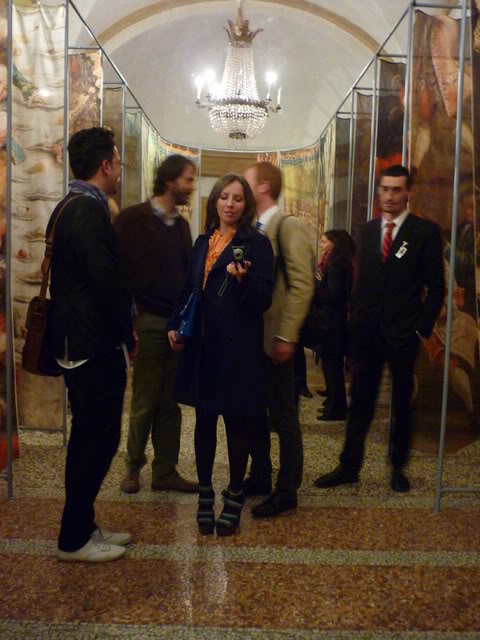 photo credit: Rowan Griffiths
photo credit: Rowan Griffiths13 September 2009 – Autumn 2011
Samuel House Estate,
[a shorter version of this review appears in The Architectural Review, November 2009]
Boarded-up housing estates have become clichéd, yet increasingly prevalent, symbols of doom and gloom in the modern urban landscape. Thankfully there are those willing to push the boundaries of such clichés, as evidenced by new installation, i am here, by artist collaboration Fugitive Images (FI). Their installation replaces 67 bright orange boards – which have covered the windows of empty flats in Samuel House since April 2007 – with large-scale photographs of residents of the estate.
Though Samuel House was formally transferred to housing association London & Quadrant Housing Trust (L&Q) in October 2008, it is not scheduled for redevelopment until late 2011. In the meantime, there has been, ‘a gradual wearing down process’ as artist Lasse Johansson calls it, in order to get residents re-housed before development works begin. As long time residents of Samuel House, Johansson, along with FI colleagues Andrea Luka Zimmerman and Tristan Fennell, have lived through flats being bricked and boarded up.
The three have been documenting the drive toward the estate’s redevelopment over the past six years in a variety of media. In addition to the ‘i am here’ project, they are also collaborating on a book and a film, both aimed at catching this particular moment of imminent change in Hackney’s urban landscape.
Johansson is surprisingly candid and captures the crux of the underlying problem with urban estate housing, especially given last year’s furore over London’s Robin Hood Gardens estate and a failed campaign to obtain listed status for the building: ‘I’ve learned a lot, both from this project, but also just from living here. Initially, I had a very black and white view of redevelopment and I began to feel very nostalgic for what we would lose, but I also could see that residents who have lived here for 20 years deserved better facilities.’
Speaking about their inspiration for the project, Zimmerman explains that it stemmed from a desire to confront this pessimism, from the estate’s residents as well as from outsiders. The charming top-floor flat Zimmerman and Johansson share faces the Regent’s Canal and both say they often struggled with comments made by passers-by. ‘People were always speculating about who lived here, whether anyone lived here’, Zimmerman says, ‘but also, there was the issue that the people who do live here were unable to project any kind of positive future for the estate. There was this idea that even in 10 years time everything would still be the same and we wanted to challenge these preconceptions.’
Zimmerman continues, ‘people saw a failed building and immediately equated it with failed inhabitants – we needed to challenge this one way dialogue and so we thought how can we make a work that addresses this idea and involves the individuals in the community.’
Armed with signatures from 98% of the estate’s residents, FI took advantage of a Community Growth Fund set up by L&Q for residents and presented their project proposal in February of this year where they were granted one-third of their budget, the rest of which was fundraised.
As to the project’s reception, Johansson says that it has definitely changed people’s perception of the estate, but he also points out that, because of city space and collective memory, the project has an infinite number of receptions: ‘it’s like Melanie Counsell’s installation at Matt’s Gallery [in 1995] when she lowered the ceiling - for those who were familiar with the gallery space, there was an immediate realisation of what had happened to the building, a different level of understanding for those in the know.’
Zimmerman chips in to clarify, ‘Of course, there are two different audiences for our project and for us they are very clearly defined: there are the people who live here and the outside world. Some of the people who didn’t live here will have remembered the orange boards and notice the difference immediately. People who have never seen the orange boards have a completely different reaction to the photos.’
Zimmerman crosses her legs before concluding, ‘A question that interests me, especially about social housing, is whether it is the building itself or the people who live in the buildings that makes it architecture? Perhaps the obvious answer is a bit of both and this project is about highlighting that.’
 Samuel House before...
Samuel House before...and after






No comments:
Post a Comment